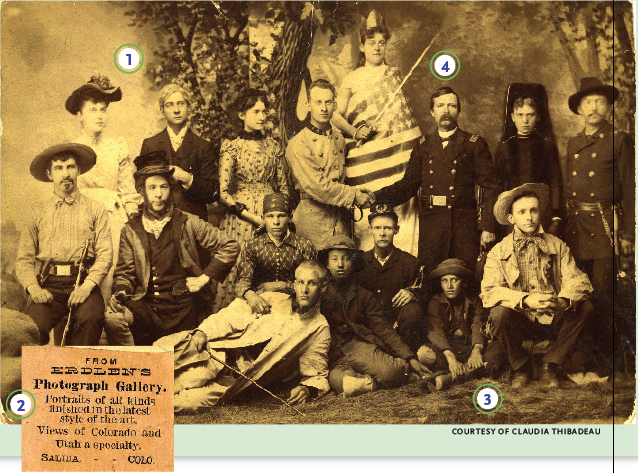Sign up for the Family Tree Newsletter Plus, you’ll receive our 10 Essential Genealogy Research Forms PDF as a special thank you!
Get Your Free Genealogy Forms
"*" indicates required fields
If every picture tells a story, this 19th-century portrait of a play’s cast of characters must have multiple plotlines. One is the mysterious tale of the man on the far left in the broad-brimmed hat: Ora Westfall, the great-grandfather of Claudia Thibadeau’s husband, who lived from 1871 to 1943. Thibadeau’s question isn’t about identifying him, but rather, deciphering the details of the event. Family history fables combine with photo clues and social history to shed light on the still-evolving mystery of Westfall’s life.
Dress rehearsal
Dating a photo of people in theatrical costume presents a challenge because everyone is dressed as a character. Fortunately, the woman standing in the back row on the left is in period clothing. Her dress, with the lacy yoke and collar and small puffs at the shoulders, as well as her simple hat, suggest the photo was taken about 1898. City directories show that the photographer, C.W. Erdlen (named on the back of the picture), had a studio in Salida from 1889 to 1898, further confirming the date.
Role play
“The family thought Westfall held many jobs, including teacher, doctor, attorney and actor,” Thibadeau says. Her research in census records, however, revealed he was listed as a laborer, farmer, tile layer and insurance agent, but none of the occupations passed down in family folklore. It seems that Westfall was a bit of a storyteller and sorting out the fact from the fiction in this picture poses a real challenge.
Westfall spent most of his adulthood in Colorado, first in Salida, then Otero. He married Honora (Nora) Ellen True in 1895 and had four children. He died in Pueblo, Colo. A descendant claims he went to normal school—a teacher’s college—in Salida. I asked James Jeffreys, a librarian at the Western History and Genealogy Department of the Denver Public Library, about Colorado normal schools. He said the state had at least two such schools in Colorado in the late 19th century—one in Greeley and the other in Boulder—but neither was near Salida.
It’s possible the normal school claim was an assumption based on the caption on the back of the image. The ballpoint-ink label reads, “Ora E. Westfall in a play at the Academy, Salida, Colo.” There’s one problem with the label: Ballpoint pens like those we use today weren’t invented until 1935, and weren’t commonplace until 1945. That means one of Westfall’s descendants—likely his daughter Gladys, who once owned this image—penned the description about 50 years after the picture was taken.
School of thought
If Westfall didn’t attend a normal school in Salida, what does the reference to the “Academy” mean? Jeffrey Donlan, director of the Salida Regional Library, sent me a Nov. 30, 1956, Mountain Mail newspaper article about the Presbyterian Academy of Salida. It opened as Central Presbyterian College in 1884 and changed its name to the Presbyterian Academy a few years later when it became an elementary and secondary school. Students were known for putting on musicals such as The Pirates of Penzance. The academy closed in 1904.
Westfall could’ve been one of the school’s first students, but at the time of this image, he was too old at 27 years. His name doesn’t appear on any lists of teachers, either. Thibadeau thinks family members confused Ora’s profession with that of his father, W.G. Westfall, a schoolteacher in Oregon. Thibadeau confirms that Westfall traveled while his wife stayed near his relatives in Oregon.
Casting call
So far, I’ve been unable to identify the play Westfall was in based on this cast portrait. Characters include Robert E. Lee and Ulysses S. Grant, who shake hands in the back row while Columbia draped in a flag observes. The person next to Grant could be a widow in mourning dress. A Civil War soldier sits beneath the clasped hands. A Southern planter in a long coat reclines in the foreground; a slave rests her arm on his shoulder. An Irish immigrant kneels next to Ora, who portrays a Western settler. Most of the actors are male; if you look closely, you’ll see that the “slave” is a boy dressed as a woman. This was common when there was a scarcity of women actors.
The photo proves Westfall was an actor at some point and was in Salida in the late 1890s, but why? The final act of this mystery has yet to play out.

1. Playing dress-up. Estimate a date based on actual clothing, not costumes.
2. Back story. Check for a photographer’s imprint or captions on the back of a photo.
3. Making headlines. Local newspapers and other sources may help explain events shown in photos.
4. Character analysis. Identifying characters may lead to the name of the play these people were in.
2. Back story. Check for a photographer’s imprint or captions on the back of a photo.
3. Making headlines. Local newspapers and other sources may help explain events shown in photos.
4. Character analysis. Identifying characters may lead to the name of the play these people were in.
From the December 2009 Family Tree Magazine
ADVERTISEMENT

